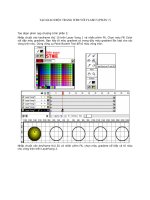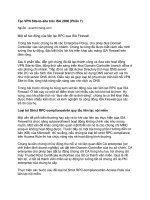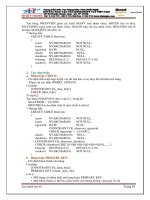mcgraw hill wireless data demystified phần 7 docx
Bạn đang xem bản rút gọn của tài liệu. Xem và tải ngay bản đầy đủ của tài liệu tại đây (520.04 KB, 59 trang )
332
Part 3: Installing and Deploying Data Networks
Scripting wrappers for file delivery specs
Part of a total mobile and wireless infrastructure solution
1
Data Synchronization Options
Data synchronization requirements for hand-helds generally fall into
one of two categories. Basic data synchronization requirements are com-
mon for relatively simple data access and collection applications that are
usually new and replace paper-based systems. The basic data synchro-
nization server acts as a communications server, managing the simulta-
neous connection of many users and passing information between the
device’s data store and a server database through a conduit. A variety of
communications modes are supported. Thus, users may connect through
desktop cradles, wireless data communications, dial-up, or direct net-
work access. Basic synchronization capabilities include:
Basic enterprise infrastructure platform features (see below)
Integration with the standard device synchronization mechanism
such as HotSync for Palm hand-helds
Multiple communications modes
Field-level change posting
Full device refresh
Refresh from an intermediate repository
Support for standard IP
Detailed logging and alerts
Extensive administrative control and configurations
Part of a total mobile and wireless data infrastructure solution
1
Basic synchronization servers typically have a documented API. The
IT organization writes the conduit previously mentioned. This conduit is
custom code written to the API of the synchronization server to define
the data mappings, data sharing, and synchronization logic and sup-
porting functionality. For straightforward applications, the conduit cod-
ing effort is easily accomplished. With more complex requirements, it is
more efficient to utilize an advanced data synchronization server than to
try to write additional functionality and management tools into your
conduit. Typical requirements that favor the robust functionality and
rich management tools of an advanced data synchronization server
include the following:
Chapter 13: Deploying Mobile Wireless Data Networks
Support for PC or laptop clients is also required
Business processes evolve rapidly
Connected users share enterprise data
Information flows between mobile users
Data refresh/realignment is required
A complex data model is being synchronized
Very large transaction volumes
Processes run against the central database
Mission-critical transactions are synchronized
Robust administrative tools are required
1
Basic data collection applications, such as inventory, warehouse, ship-
ping, inspections, and meter reading, often find basic synchronization
solutions adequate to meet their requirements. When the preceding crite-
ria are present, purchasing an advanced data synchronization engine will
provide significant cost savings when compared with the cost of writing,
supporting, and debugging a large amount of custom conduit code written
to define sharing rules and provide the features mentioned next. If your
needs require an advanced data synchronization solution, look for the fol-
lowing features to be sure you are getting everything you’ll need:
Basic enterprise infrastructure platform features (see below)
Support for heterogeneous databases
Store-and-forward architecture
Fast synchronization sessions
Rich administrative tools
Change capture including triggers, ODBC, and logs
Transaction support—serialization and rollback
Flexible conflict management and resolution
Support for multiple communications layers
Full bidirectional synchronization with sharing logic
Parameterized sharing rules
Field-level synchronization, partitioning, and data mapping
Performance tuning utilities
Support for complex database schema
Nonintrusive architecture to easily integrate
333
334
Part 3: Installing and Deploying Data Networks
Sharing realignment and full client refresh capabilities
An API for custom modifications
SQL function trapping to preserve integrity
Client-side error logging
Part of a total mobile and wireless infrastructure solution
1
Building in all these features via custom coding to augment the basic
data synchronization communication server can drain significant resources.
However, these capabilities are vital in managing your mission-critical
enterprise data. As a result, organizations should look to buy, rather than
build, an advanced data synchronization engine.
With basic PIM and e-mail synchronization, personalized file distribu-
tion, and data synchronization set up, you’ll be providing users with most
of the information they need to be productive, and you’ll be effortlessly
gathering and consolidating data from the field. Next, let’s address some
of the administrator’s needs.
System Management and Inventory
Synchronization of corporate data often requires that related applica-
tions be deployed on the mobile devices. Management of application soft-
ware and systems quickly also becomes a major requirement of a mobile
infrastructure strategy.
Application Management
LAN-based approaches to system management of mobile devices are
usually unworkable. Mobile users are intermittently connected through
unreliable communications and require event-driven synchronization
sessions. These factors introduce unique requirements. Support staff are
unable to physically access the machine and must somehow keep track
of overall inventory and the individual characteristics of each device.
Thus, mobile and wireless data devices demand a different type of
system management solution, one that complements existing systems,
but meets the unique needs of the occasionally connected user. Key fea-
tures of a mobile system management solution should include:
Basic enterprise infrastructure platform features (see below)
Self-upgrade support and healing
Delivery logging
Chapter 13: Deploying Mobile Wireless Data Networks
Publish and subscribe model
Software package wizard
Device history tracking
Software inventory
Scripts that are able to access inventory data
Scanner utility
Byte-level file differencing
Offline installation
Versioning
Part of a total mobile and wireless infrastructure solution
1
Utilizing software distribution capabilities makes the IT staff more
efficient at managing the mobile devices, protects user productivity, low-
ers costly support incidents, and prevents user downtime.
Managing the Mobile Network
A comprehensive mobile infrastructure solution is necessary to achieve
consistent and efficient management of your mobile network. Reactive
and fragmented support is not an option. Deployment of one integrated
mobile computing suite, complete with common administrative and user
interfaces, will provide a host of benefits.
Demand Comprehensive and Fully
Integrated Service
Working with a single vendor means a single contract and a single
source for support. Integrated administration reduces duplicated efforts,
provides for a simple and efficient end-user interface, and reduces train-
ing for IT staff by eliminating multiple tool sets. Cost savings are also
realized through the elimination of application integration costs and
reduced license, maintenance, and support expenses.
You should look for a strong underlying platform in the solutions you
consider. Must-have features include the following:
Support for all major hand-held devices
Integrated management
Multiple connection modes
335
336
Part 3: Installing and Deploying Data Networks
Remote server administration
Administrative database
Compression
Scalable architecture
Alerts and notifications
Microsoft Management Console plug-in
Directory services integration
NT domain authentication
Manage performance thresholds and load balancing
Server-side process execution
Encryption
Open APIs
Checkpoint restart in communications
Standard Internet technologies
Guaranteed delivery
Logging and reporting
Administrator-set scheduled connections
Administrative Console
The administrative console is the focal point for configuring and manag-
ing your mobile and wireless data infrastructure. It should offer a
robust administrative interface for maintaining the settings and rules
that drive the behavior of server-based engines.
Ideally, you can have one administrative console that manages all
functions for all mobile devices you support. This console should allow
system managers to:
Define the user base
Define activities (file, software, e-mail, and data distributions)
Subscribe users to activities
Prioritize the order of activity execution
Review extensive system logs
Review mobile device inventory
Set alerts and notifications
Troubleshoot and address problems
1
Chapter 13: Deploying Mobile Wireless Data Networks
The administrative interface will allow you to interact with the
mobile wireless data network, provision new users, model changing
business processes, track down problems, monitor the aggregate device
inventory for planning, and complete all the other day-to-day tasks
involved in supporting mobile users. It’s important to have one central
console, instead of learning a variety of administrative interfaces and
duplicating tasks such as assigning a new user to a profile. Ideally, you
can manage the entire mobile network from one GUI.
Communications Options
A variety of communications options are available for connecting hand-
held devices to company servers for synchronization. It is very likely, and
often advisable, for your organization to employ a mix of the following:
Cradle to PC synchronization, which requires some sort of staging on PC
Cradle through PC to network synchronization
Network cradle synchronization
Network dial-up (wired and wireless data)
Wireless data direct to server over Internet synchronization (also
wired)
1
The specific options available will vary for different hand-helds, and
for different communications/networking providers. A full review of
these is beyond the scope of this chapter. The important thing to keep in
mind is that the networking and connection options must serve the user.
And mobile users need options to stay connected when they are out of
range of a wireless data connection, or have only a low-bandwidth dial-up
connection available from a hotel, for instance.
So, your hand-held infrastructure solution, including the synchro-
nization and management tools, will need to support a range of commu-
nications protocols and transport mechanisms. The vendor should be
committed to providing a total solution with the flexibility you need
today—and tomorrow.
Security Concerns
IT is ultimately responsible for the integrity, confidentiality, and avail-
ability of the enterprise system. A comprehensive infrastructure plan
will include the early integration of security solutions. The most basic
337
338
Part 3: Installing and Deploying Data Networks
and inherent security risk posed by a mobile device is that it is not bolted
down. It walks out your doors every afternoon. It is left in your salesper-
son’s car. It is carried on planes, trains, and automobiles, and left in hotel
rooms around the world. And it contains information critical to your
business.
Security on the New Frontier
Mobile enterprise security is founded in policy and supported by cutting-
edge technology. A comprehensive mobile enterprise security solution
will include:
Broad platform support. From enterprise and e-commerce
3
servers,
to desktops and Java, all the way down to PDAs, smart phones, and
Internet appliances.
Standards compliance. Support for all the current and de facto
standards, and complete interoperability with past, present, and
planned installations.
Network independence. The ability to build a solution for
Internet, intranet, wireless data, and even nonstandard networks.
Mobile, hand-held, and embedded specialization. Toolkits optimized
to provide full-strength security that is small, fast, and efficient even
in the smallest devices.
Client authentication. Provide the highest form of security on any
platform, even hand-helds—a must-have feature for enterprise data
access and financial transactions.
1
Conclusion
In midst of challenges to launching an enterprise hand-held wireless data
deployment, how are companies realizing success? The answer is some-
thing of an enterprise epiphany: whenever CEOs and CFOs say to them-
selves, “We are going to have a mobile wireless data network and we are
not afraid to support it.” The moment strikes when decision makers real-
ize that to become more effective, more efficient, and more competitive,
they don’t have to develop big pieces of software. They discover that
mobility is less about moving people and more about moving information.
They discover that smaller pieces of software can be rapidly deployed to
hand-helds which link back to their server and effectively push critical
data out into the field where users interact with the market.
Chapter 13: Deploying Mobile Wireless Data Networks
Now, the person you could have given a $4000 laptop is doing the
same effective work with a $149 Palm OS hand-held because you have
harnessed the information technology power of your existing back-end
infrastructure. It’s a small price to pay when you stand to gain a full
return on your investment in as little as 2 months. And, having deployed
a flexible mobile and wireless data infrastructure platform, no matter
what new mobile device is coming, your wireless data network is pre-
pared to meet it head on.
References
1. The Handheld Applications Guidebook: Getting Started Deploying
and Supporting Enterprise Applications on Handheld PDAs, Synchro-
logic, Inc., 200 North Point Center East, Suite 600, Alpharetta, GA
30022, 2002.
2. John R. Vacca, i-mode Crash Course, McGraw-Hill, 2001.
3. John R. Vacca, Electronic Commerce, 3d ed., Charles River Media, 2001.
339
This page intentionally left blank.
Implementing
Terrestrial Fixed
Wireless Data
Networks
14
CHAPTER
14
Copyright 2003 by The McGraw-Hill Companies, Inc. Click Here for Terms of Use.
342
Part 3: Installing and Deploying Data Networks
Terrestrial wireless data communication may be mobile
4
or fixed. The
first and second generations of wireless data technology emphasized
mobility and lower frequencies, since they sought to provide only basic
wireless data telephony and low-speed data communications. The third
generation saw mobile technologies operate in higher frequencies (such
as the 2-GHz PCS band) while coverage zones expanded, power needs
fell, data rates rose, and more services were supported. Simultaneously,
third-generation terrestrial fixed technologies made dramatic leaps into
upper-band frequencies (24 to 39 GHz), attaining data rates as high as
wireline technologies so as to support a range of hypercommunication
services including voice, video, high-speed data, and Internet.
In this chapter, the implementation of terrestrial (nonsatellite) fixed
wireless data technologies is discussed. As with wireline technologies,
almost every specific service can be provided by terrestrial fixed wireless
data technologies. The ability of terrestrial fixed wireless data technolo-
gies to serve as access paths for hypercommunication services depends
mainly on signal frequency, user mobility, and the availability of appropri-
ate antennas, DCE, and DTE. (The Glossary defines many technical terms,
abbreviations, and acronyms used in the book.) Table 14-1 details terres-
trial fixed wireless data technologies that are used to support mobile and
nomadic services.
1
Typically, mobile user devices include DTE, DCE, and an antenna in a
single unit. Mobile services are provided by carriers in a series of overlap-
ping coverage zones (cells), each of which is served by a tower attached to
base stations. As subscribers travel in their carrier’s local footprint, calls
are passed from one cell to another. Subscribers may roam regionally or
nationally and use their own (or another) carrier’s network if compatible
technologies are available in the roamed area.
Available Terrestrial Fixed Wireless
Data Technologies
Table 14-2 lists several terrestrial fixed wireless data technologies that
are available.
1
For each technology, the typical frequency and channel
bandwidth, data rate, and services supported are shown. Since terrestrial
fixed wireless data technologies are works in progress, the table cannot
convey more than a broad general categorization. Hence, the specific tech-
nologies listed in the table are often imprecise terms, based on a melding
of traditional FCC definitions, proposed frequencies, experimental tests,
and implementations by carriers.
The first fixed terrestrial wireless technologies are WLAN (wireless
LAN) technologies. The first type of WLAN is infrared WLAN. Infrared
Market Frequency
Technology Applications (Channel Bandwidth) Data Rate
CDMA Two-way paging, digital 900−941 MHz 6.4−25.6 kbps
(narrowband mobile enhanced (25 MHz)
PCS) telephony
CSCD Fax, file transfer, Internet 800-MHz analog 1.2−9.6 kbps,
cellular 14.4 kbps
(25 MHz) optimally
CDPD (analog Two-way paging, POS, data 800 MHz 4.8−12 kbps
and early digital queries, dispatch, on (12.5−30 MHz)
cellular overlay) analog cellular line
Digital cellular− Two-way paging, fax, 800, 900, 1900 MHz 9.6−14.4 kbps
PCS (IS-136 e-mail, enhanced digital (25−200 MHz) (current),
TDMA, IS-95 telephony 1.2 Mbps
CDMA) (spread spec-
trum, future)
ARDIS Two-way paging, 800 MHz (25 MHz) 2.4 kbps
(Motorola transportation data (nationwide),
DataTAC) support, in-building 9.6 kbps
wireless (limited)
BellSouth Two-way paging, dispatch, 900 MHz (12.5 kHz) 4.8 kbps
wireless data database
(Mobiltex)
AMPS cellular Mobile telephony, 400 MHz (25 MHz) 4.8−9.6 kbps;
telephone modem applications see also
CDPD, CSCD
iDEN Enhanced digital mobile 800−960 MHz 9.6−64 kbps
(SMR, ESMR) telephony, Internet, e-mail, (15−30 MHz) (Nextel)
dispatch
GSM-1900, Enhanced digital mobile 1.9−2.1 GHz 300 kbps
TDMA (broad- telephony, file transfer, (200 MHz) (extended
band PCS) Internet, e-mail range), up to
2 Mbps
(local CZ)
TABLE 14-1
Mobile Terrestrial
Fixed Wireless Data
Technologies
Chapter 14: Implementing Terrestrial Fixed Data Networks
adapters plug into token ring cards to allow localized transmissions
(within 80 ft). While infrared can be used between buildings, it is so sus-
ceptible to fog, rain, and smog interference (since it is a form of light)
that it is usually used for remote controls, wireless keyboards, and wire-
less computer mice.
For example, the WLAN hardware market (which is driven in part by
wireless data collection) will grow at better than 36 percent annually
343
344
Part 3: Installing and Deploying Data Networks
through 2006. Bar-code data collection is another fixed terrestrial wire-
less data infrastructure that’s increasingly wireless, distributed, and
based on common IT standards (see sidebar, “Terrestrial Fixed Wireless
Bar-Code Data Collection”).
Terrestrial Fixed Wireless Bar-Code Data Collection
Deploying an enterprise resources planning (ERP) system put
Laufen USA’s ability to manage transactions and information on a
whole new level. But managers at this Tulsa, Oklahoma−based man-
ufacturer of prefired tile needed to find a way to extend that level of
information management to Laufen’s warehouse operations.
Typical Frequency Data Rate
Technology Market (Channel Bandwidth) (Range)
WLAN Segments of LANs 3000−30,000 GHz 4−16 Mbps
via infrared (with token
ring card,
80 ft)
WLAN via laser Local-area network 30−150 THz To 16 Mbps
in office or campus (800-nm waves) (3280 ft, line
of sight)
WLAN via RF Local-area network in 5.1−5.8 GHz 10−100 Mbps
office or campus (30−100 MHz), (3280 ft in
unlicensed spread open, 650 ft
spectrum in building)
2.4-GHz WCS WWAN, WLAN, and (1−25 MHz per channel), 156 kbps to
Internet access unlicensed spread 11 Mbps (up to
2.402−2.48 GHz spectrum 10−25 miles)
DEMS Broadband microwave 24 GHz (100 MHz) Up to 30 Mbps
access: telephony, WAN, (2−10 miles)
video, Internet
MMDS Microwave access: 2−2.6 GHz Up to 10 Mbps
telephony, data, video, (190−200 MHz) (30−35 miles,
Internet one-way; 6
miles, two-way)
WLL Broadband microwave 39 GHz 45−155 Mbps
access and WAN: data, (100 MHz−1.4 GHz) (2−5 miles,
Internet, ATM, telephony, possibly 9−10)
video
TABLE 14-2
Terrestrial Fixed
Wireless Access
Technologies
Chapter 14: Implementing Terrestrial Fixed Data Networks
345
The solution the company settled on was the deployment of a
terrestrial fixed wireless automatic data collection system that it
integrated with the warehouse management and data capture
functions of its ERP system, from Herndon, Virginia–based The
Baan Co. The solution eliminates the need to manually enter data
about the movement of goods in the warehouse, while doing away
with paper-based methods.
Laufen’s Baan ERP system allowed the company to control the
warehouse, but it was still a manual data entry process. Laufen
needed a real-time solution that would feed information back to
their ERP database as warehouse and inventory transactions occur.
The solution that Laufen chose uses standard terrestrial fixed
wireless local-area network (WLAN) technology, and builds upon
the ERP investment the company was making. In so doing, the
deployment exemplifies a couple of trends. One is a continuation of
the long-held value proposition behind data collection that it
increases the value of existing systems by improving the timeliness
and accuracy of data. The second trend (the deployment of data col-
lection solutions that are increasingly wireless and built on ubiqui-
tous IT standards) is evolving more rapidly, and involves a host of
technologies.
But, for the time being, data collection’s use remains closely tied
to the health of the market for transactional systems such as ERP
that rely on data collection as a means of recording transactions.
With the economy inching its way back to health, some observers
expect that data collection deployments will pick up. The next step
in many existing ERP deployments is to automate that “last mile,”
down to where the data are generated.
As the economy picks up, a lot of manufacturers are going to be
looking around at where they can gain the next set of efficiencies
and save money. Many will realize that one way to do that is with
better data.
Research from Venture Development Corp. (VDC), Natick, Mass-
achusetts, bears out the dual nature of the data collection market.
VDC estimates that growth for some long-established segments of
the data collection market (such as hand-held scanners and bar-
code printers) will be relatively modest through 2006, with scanner
sales increasing just 6 percent, and printers by 9.7 percent. On the
other hand, VDC estimates that the WLAN hardware market (which
is driven in part by wireless data collection) will grow at better than
36 percent annually through 2006. The result is a data collection
market in transition—with data collection continuing as a valued
346
Part 3: Installing and Deploying Data Networks
extension to enterprise systems and other applications, while new
mobile applications also drive growth.
Solid Payback
Laufen operates on a 24 ϫ 7 basis, shipping about 280 truckloads
(5600 pallets) of tile each month. Prior to 1998, the company’s main
warehouse was located 15 miles from its headquarters. With more
orders to fill, it became clear that the warehouse should be on site.
The move was an ideal time to implement new systems.
As part of the move to the new 193,000-ft
2
facility, Laufen began
its search for systems integration firms capable of adding wireless
data-capture functionality to the ERP system. Laufen selected
Jump Technology Services, also of Tulsa, as its integration firm,
and Jump recommended terrestrial fixed wireless data collection
equipment from Intermec. Going with a terrestrial fixed wireless
data system made the most sense, given the size of the facility.
Intermec T2425 Trakker Antares hand-held and T2455 vehicle-
mounted computers replaced the handwritten log sheets in the
Laufen warehouse, all tied together with an Intermec 2.4-GHz ter-
restrial fixed wireless data backbone. The units are used to scan
pallets of tile as they move through Laufen’s production and ship-
ping processes.
A single scan of the pallet label at the production line prompts the
system to post a quantity to the production batch, and closes the
batch if complete, placing it in a finished goods receipt location.
These transactions used to require multiple manual entries.
Information from the scanned bar code travels from the mobile
scanner through the terrestrial fixed wireless data backbone. Inter-
mec access points strategically placed in the rafters of the warehouse
work with a repeater to boost the radio signal to the network con-
troller, which links to the ERP system.
As pallets of boxed tiles arrive at the warehouse aboard a truck
from a holding location near the production line, a worker scans
the bar-code labels. This updates the data-capture system on the
pallets’ status and automatically provides an audit trail.
A forklift driver takes the pallets to randomly chosen storage
slots within the warehouse aisles. Each of the slots is identified
with a bar-code label. The driver scans the bar-code labels on both
the pallet and the intended slot. This prompts the system to link
the product with its location. It also notes the production date,
allowing the system to track product by age.
Chapter 14: Implementing Terrestrial Fixed Data Networks
The last WAN technology includes the 5.8-GHz spread-spectrum tech-
nologies that make use of unlicensed spectra to operate on a single
premises. Spread-spectrum technologies allow low-power operation and
reduce interference. In open spaces, 100-Mbps ranges for wireless data
LANs (such as the Breeze Net Pro.11 product line) can range from 1000
m (3280 ft) in open areas to 60 to 200 m (200 to 650 ft) inside buildings.
Wireless Local-Area Networks
WLANs use all-wireless data Ethernet and specialized hybrid technologies.
An all-wireless data Ethernet LAN replaces cabling
6
among computers in
347
After relocating to the new warehouse and going live with the
data collection system, Laufen began to see results almost immedi-
ately. It has better visibility of the product. The system allows it to
operate more efficiently, and make better use of its people.
More Mobility
While terrestrial fixed wireless data collection has a relatively long
history in warehouse settings, some see broader-ranging mobile
data collection as the future. Today, the acceptance of PDAs, terres-
trial fixed wireless data and cellular networks, and mechanisms
for data synchronization is such that there are fewer boundaries
to data collection and to simplified, bidirectional interaction with
systems.
In a bidirectional mode, devices function as full-fledged computers
that can access applications over terrestrial fixed wireless data net-
works and receive alerts, not simply scan bar codes. Such devices are
Web-enabled and WLAN-compatible, allowing them to communicate
wirelessly while on the road or within a sprawling facility.
Symbol Technologies (Holtsville, New York) recently announced
that London-based petrochemical giant BP is implementing Sym-
bol’s mobile data collection solutions at multiple sites worldwide.
The systems, utilizing WLAN technology, will support asset man-
agement of thousands of pieces of equipment in BP’s refineries.
New devices running on Windows CE or the Palm operating sys-
tem also are part of the mobile data collection trend. If you look at
some of the units today, such as the Intermec Model 700, it’s a
pocket PC with all the ability to run applications that the platform
brings with it.
2
348
Part 3: Installing and Deploying Data Networks
a local network with wireless data paths, so individual computers
require antennas to transmit to the network host. With all-wireless data
Ethernet technologies, laptop computers connect to the WLAN through
antennas in their PCMIA slots and remain portable in the office. Hybrid
WLAN technologies use wireline cabling to connect each machine in a
particular area to a hub (or other intermediate DCE), but use wireless
data paths from hub to central server.
The second WLAN technology, WCS, may be particularly useful for
agribusinesses seeking to interconnect LANs inside a 10- to 25-mile
radius of a central site [creating wireless data WANs (WDWANs)], or to
obtain Internet access. The 2.4-GHz WCS band is also unlicensed spec-
trum that can be used on the local or access level. Since spectrum is
unlicensed, the FCC requires that spread-spectrum technologies be used
that make radio signals appear as background noise to unintended
receivers. For example, numerous service providers in many parts of
Florida are currently offering wireless data Internet access in the 2.4-
GHz band. However, interference from garage door openers, baby moni-
tors, and other wireless data equipment can occur in the unlicensed fre-
quencies used by WCS.
DEMS is a two-way all-digital system that uses digital termination
systems (DTSs) on each end as DCE. An important characteristic of
DEMS is proper antenna placement. User stations require directional
antennas over a 2- to 10-mile-long path length. In 1998, Teligent
began to provide the first DEMS service in Florida to metro Jack-
sonville, Tampa, Orlando, Palm Beach County, and Miami−Dade
County.
Upper-Band Technologies
Teligent’s DEMS technologies use a two-step wireless data layout. In the
first step, at the access level, when a customer makes a telephone call or
accesses the Internet, the voice, data, or video signals travel over the
building’s internal wiring to the rooftop antenna. These signals are then
digitized and transmitted to a base station antenna on another building,
usually less than 3 miles away. The DEMS base station functions as a
POP for that area, gathering signals from a cluster of surrounding cus-
tomer buildings, aggregates the signals, and then routes them to a
broadband switching
7
center (see sidebar, “Terrestrial Fixed Wireless
Broadband Links”).
Chapter 14: Implementing Terrestrial Fixed Data Networks
349
Terrestrial Fixed Wireless Broadband Links
HTE8 began deployment of its domestic terrestrial fixed wireless
data broadband network in Houston, providing connectivity to
businesses that require reliable, easily deployed bandwidth solu-
tions. HTE8’s scalable networks allow for connections up to
44 Mbps, enabling enterprises to conduct business functions over
the Internet in a high-throughput, secure environment.
HTE8’s network design consists of eight nodes, providing cover-
age of over 90 percent of the Houston market. The transmission
nodes utilize fiber-optic backhaul from several network partners to
HTE8’s point of presence at Level 3’s Houston facility, assuring
quality transmissions. Each node reaches up to 24 miles line-of-
sight, and up to 15 miles non-line-of-sight. HTE8 intends to reach
areas that have inadequate access to broadband connectivity, yet
have high bandwidth requirements. With only 4 percent of build-
ings connected to fiber, and only 50 percent of any given market
addressable by DSL, terrestrial fixed wireless data solutions bridge
the gap between those businesses that have the advantage of
speedy Internet access and those that don’t.
Based on Cisco Systems’
5
terrestrial fixed wireless data broad-
band technology, HTE8’s networks utilize hardware incorporating
vector orthogonal frequency-division multiplexing (VOFDM),
which enables non-line-of-sight implementations. HTE8’s net-
works also implement point-to-multipoint transmissions, provid-
ing more scalable network deployments, thus allowing HTE8 to
reach customers with diverse bandwidth requirements in a vari-
ety of configurations. Multitenant units in areas outside major
metropolitan centers can receive state-of-the-art bandwidth solu-
tions at lower costs and with faster provisioning times than his-
torically available.
HTE8 works with service providers, such as ISPs, data centers,
storage facilities, ASPs, and CLECs, to provide options for last-mile
connectivity. Additionally, these companies utilize terrestrial fixed
wireless data broadband for redundancy in addition to traditional
terrestrial connectivity to insure mission-critical applications.
Fiber-optic networks do not always reach the curb. HTE8 is able to
reach customers and extend networks to locations for a fraction of
the cost of fiber.
3
350
Part 3: Installing and Deploying Data Networks
MMDS is authorized at 190 MHz of spectrum near 2.5 GHz. MMDS
architectures are designed for fairly large coverage zones, up to 50 km
across. Typical MMDS reflector antennas are up to 0.6 m (2 ft) in diameter.
Designed as “wireless data cable TV,” downstream MMDS signals can
cover up to a 35-mile radius. Hence, MMDS technology is expected to
have a broader market and more coverage of rural areas. However, until
now, upstream (symmetric) MMDS has been limited to a 6-mile range.
MMDS is often seen as a Small Office Home Office (SOHO) technology if
the technology can become more adept at achieving symmetric data
rates over distance and at sharing scarce frequency. Typical MMDS or
customer premises equipment includes a roof-mounted transceiver and
antenna, an up/downconverter to change signal frequency to frequencies
usable by DTE, a network interface unit (NIU)—possibly a telephone
interface—and an Ethernet hub or router.
WLL is still another upper-band technology christened as “fiber in the
sky.” Wireless POPs are centrally placed in urban areas with access
accomplished via multitenant environment (MTE) office building rooftop
transmitters to wireless data hub paths. Estimates are that only 3 per-
cent of office buildings have fiber, but that they represent one-third of
all business communication lines. WLL is targeted at this 3 percent (the
power users), while MMDS, and to a lesser extent 2.4 GHz, is aimed at
the 97 percent without fiber access—the smaller business customer.
CDMA technology is used to economize on spectrum, so individual
clients may maximize data rates. The 39-GHz band in which WLL will
operate can carry data rates of up to 155 Mbps over several miles. Win-
star is a WLL provider in Florida, with the right to provide coverage from
Jacksonville to Miami along the Atlantic Coast and from Citrus County
south to Everglades City on the Gulf Coast.
The new upper-band technologies are no panacea for rural areas.
According to the NTIA, most applications are for dense urban MTE loca-
tions.
New and proposed terrestrial fixed wireless data systems are being
developed to exploit shorter-range, cellular deployments able to serve a
much denser subscriber base, using multipurpose digital bit streams.
These emerging systems will need to be much smarter and more com-
plex than traditional systems, and they will demand extensive infra-
structure development and integration into existing telecommunication
infrastructures. Additionally, upper-band technologies may not hold
great promise for a high-rainfall state such as Florida, since the South-
east is one of the worst areas for microwave signal propagation
In spite of predictions by others that terrestrial fixed wireless data
bandwidth would be boundless in 2003, this author has different predic-
tions for 2003: Wireless data users may hit a speed bump because of lim-
itations on spectrum and failure to deploy equipment in many areas.
Chapter 14: Implementing Terrestrial Fixed Data Networks
While terrestrial fixed wireless data technologies are developing slowly,
inexpensive, symmetric satellite technologies
8
are coming even more
slowly.
Conclusion
The best way to explain what terrestrial fixed wireless data technologies
services and technologies are is by reviewing Fig. 14-1.
1
The seven layers
of the OSI model are important in regard to technical issues of private
data networking and the Internet.
The bottom of the figure represents the local, physical level that con-
tains the local communications network and equipment. Most businesses
have some computer equipment that may be used for private data net-
working or the Internet and telephone equipment to connect with the
PSTN. The larger a business is, the more dependent on technology it is,
and the more it has to communicate over long distances, the sooner it is
likely to try to converge voice, Internet, and data into a single terrestrial
fixed wireless data network. On a corporate premises, convergence
means that it’s currently separate voice, Internet, and data equipment
and currently separate conduit will evolve into a unified whole.
However, even if terrestrial fixed wireless data services and technolo-
gies allowed smaller businesses to unify their networks, and even if the
CPE needed to do the job was available, a high-speed connection to access
the advanced terrestrial fixed wireless data network of the future would
be needed. In many places, this last-mile connection is not yet able to han-
dle convergence inexpensively if at all.
There are several reasons the promise of the future is hindered by the
reality of the present. The infrastructure that connects a communica-
tions provider’s POP to the business location varies from one location to
another. Currently, wireline service may rely on the copper loop from the
ILEC, a hybrid fiber-coax mix from the cable company, and the ability to
connect directly to a fiber-optic network. Terrestrial wireless data access
can be fixed, nomadic, or mobile depending on the movement of the user.
Of the three kinds of terrestrial wireless data access, only fixed terres-
trial is likely to compete sufficiently with the wireline infrastructure.
However, most providers (wireline or wireless) have not worked out all
the kinks in urban areas to provide a single link to businesses. In rural
areas, the situation is even less developed.
In the future, a particular business may be able to obtain high-speed
network access from competing providers and services for each of these
four sources. At present, many businesses can obtain high-speed dedi-
cated digital or circuit-switched digital access over copper from a single
351
352
E-commerce
Cell-switched services
Packet-switched services
PSTN
WWW
Internet
Applications
WAN
Applications
Call Centers
and CTI
Telephony
SONET
Fiber Optics
Dedicated
Digital
Circuits
Circuit-
Switched
Digital
Analog
POTS
Copper
Enhanced
Mobile
Telephony
Wireless
Technologies
Enhanced Telecommunications
CPE
Private Data Networking
CPE
Wireless Transmission Technologies
Wireless Transmission Technologies
Support and
Managed Services
Access-Level
Services
(connections)
Transport-Level Services (networks)
Application-Level Services (value-added)
Figure 14-1
Terrestrial fixed wireless data services and technologies.
Chapter 14: Implementing Terrestrial Fixed Data Networks
provider—the ILEC. Larger businesses with offices located in urbanized
areas may have more providers (ILECs) willing to serve them by
reselling the ILEC’s copper loop or by using a fiber network that bypasses
the local copper loop. Suburban locations may have cable or DSL access.
However, most of these access level services are sold separately for Inter-
net, data, and telephony.
Once businesses can obtain a single high-speed access-level connection to
transport-level services (PSTN, ATM, and packet-switched networks), they
will benefit from converged hypercommunication networks. Now, transport-
level services are available and affordable only by large, strategically located
businesses. As communication needs change, technology improves, and
costs fall, transport-level services such as ATM should become more avail-
able and more demanded by businesses.
Application-level services or value-added services are currently available
at least at low speeds to most businesses. New kinds of application-level
services and value-added services will increase the benefits of high-speed
terrestrial fixed wireless data networking. Even if high-speed access to
intelligent networks was available to all businesses today, there would
have to be demonstrable business reasons to adopt convergence technolo-
gies today. It may be expected that the earliest businesses to foresee innov-
ative uses of terrestrial fixed wireless data will achieve supernormal prof-
its from their use. This, in turn, will entice others to follow them. Just as
with other technological changes, those who are slow to act may be left
behind.
Now that a picture of what terrestrial fixed wireless data services and
technologies are has been painted, and some of the most promising ones
for businesses have been identified, the job is not over. Next, it is impor-
tant to consider to what role location will play along with taxes and
other government policies in allowing terrestrial fixed wireless data to
reach rural locations.
References
1. Dr. Dean G. “Gordy” Fairchild, “Hypercommunications Convergence:
Services and Technologies,” 2645 S. 81st Lane, Phoenix, AZ 85043-5434,
2002.
2. Roberto Michel, “New Routes to Better Data,” MSI, Reed Business Infor-
mation, 2000 Clearwater Drive, Oak Brook, IL 60523, 2002.
3. “HTE8 Deploys Fixed Wireless Broadband Links throughout Houston,”
Business Wire, 40 E. 52 St., 14th Floor, New York, NY 10022, 2002.
4. John R. Vacca, i-mode Crash Course, McGraw-Hill, 2001.
353
354
Part 3: Installing and Deploying Data Networks
5. John R. Vacca, High-Speed Cisco Networks: Planning, Design, and
Implementation, CRC Press, 2002.
6. John R. Vacca, The Cabling Handbook, 2d ed., Prentice Hall, 2001.
7. John R. Vacca, Wireless Broadband Networks Handbook, McGraw-Hill,
2001.
8. John R. Vacca, Satellite Encryption, Academic Press, 1999.
Implementing
Wireless Data and
Mobile Applications
15
CHAPTER
15
Copyright 2003 by The McGraw-Hill Companies, Inc. Click Here for Terms of Use.
356
Part 3: Installing and Deploying Data Networks
The implementation of mobile wireless data applications
2
is becoming
increasingly visible in virtually all industries. This interest has fueled
explosive growth in the mobile wireless data device market—despite the
recent slowdown in the tech sector of the worldwide economy. According
to Gartner Group, the worldwide mobile PC market grew by 43.8 per-
cent in the first quarter of 2002 compared with the first quarter of 2001.
Add hand-helds into the equation and today’s enterprise is faced with
a virtual flood of mobile wireless data devices. Meta Group has predict-
ed that, by 2005, each corporate knowledge worker will have four to five
different computing and information access devices that will be used to
access various applications.
When mobilizing wireless data applications, the enterprise must
answer several questions. Which devices support existing business prac-
tices? How will those devices connect to the network? How much func-
tionality will reside on the devices? And how will the information on
those devices be kept in sync with server information? This chapter
answers the last question—too often the most overlooked component of
going mobile. (The Glossary defines many technical terms, abbreviations,
and acronyms used in the book.)
Why Synchronization?
In mobilizing wireless data enterprise applications, one of the most
important questions your corporation must answer is what type of archi-
tecture will allow mobile users to connect to corporate servers. There are
two options to consider here: synchronization and real-time access.
Real-Time Access
In real-time environments, users are perpetually connected to corporate
servers and applications. Mobile wireless data devices are essentially
terminals—storing no data or applications locally. Data are viewed as
they are entered, with the mobile experience hinging on network perfor-
mance and available bandwidth.
This environment, well-suited for LAN-connected users, faces chal-
lenges in the reality of wireless data instability. Occasional interrup-
tions in network availability can be devastating to mobile users whose
devices store no data or applications locally. Mobile users are at the
mercy of the connection availability, unable to compensate for lapses in
coverage.









